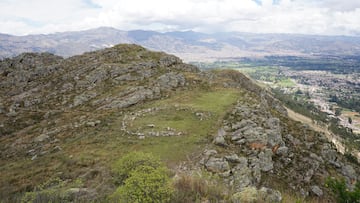Construction older than the pyramids of Egypt found in Peru
Archaeologists from the University of Wyoming have uncovered a circular stone plaza in Peru. The megalithic structure predates the Egyptian pyramids.

Archaeologists from the University of Wyoming revealed the existence of a circular plaza in Peru older than the pyramids of Egypt. Specifically, they were located in the archaeological site of Callacpuma, in the Cajamarca region of northern Peru.
The study, published in the scientific journal Science Advances, dates the construction of this structure to the Late Preceramic period, 4,750 years ago. It is a structure made up of large independent megalithic stones placed vertically. According to the authors of the research, an arrangement with similar characteristics had never been seen before in the Peruvian Andes.
It is also considered “one of the earliest examples of monumental, megalithic ceremonial architecture in the Americas.” In order to date the construction of the circular plaza, archaeologists proposed three radiocarbon dates “associated with the initial construction, which “which average to approximately 2750 calibrated years before the common era (cal BCE).”
Construction of 18 meters in diameter
Regarding megalithic stones, large platforms and buildings, or delimited squares, the study also mentioned other better-known works, such as Stonehenge in England, the pyramids of Giza in Egypt, Göbekli Tepe in Turkey. As for the circular plaza of Cajamarca, its dimensions are 18 meters in diameter, or roughly 60 feet.
Regarding the research work, the charcoal fragments from the foundations of the monumental stone walls that the archaeologists recovered were also key. These were found in a thin layer “of mixed soil, clay, gravels, and small charcoal fragments, laid directly upon bedrock where builders planned to erect stone walls,” the researchers explained.
“It was probably a gathering place and ceremonial location for some of the earliest people living in this part of the Cajamarca Valley,” said archaeologist Jason Toohey. “These people were living a primarily hunting-and-gathering lifestyle and probably had only recently begun growing crops and domesticating animals,” he added.
At the same time, it is a lesser known construction in the highlands of the Andes, unlike what was happening with other locations nearby. Previously, only three other highland examples have been discussed: La Galgada, Kuntur Wasi, and the Early Horizon site of Chavín de Huantar. Various lines of material evidence suggest that the circular plaza of Callacpuma is one of the oldest monumental and megalithic structures in the Peruvian Andes.





